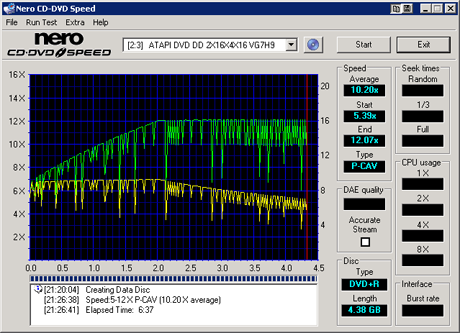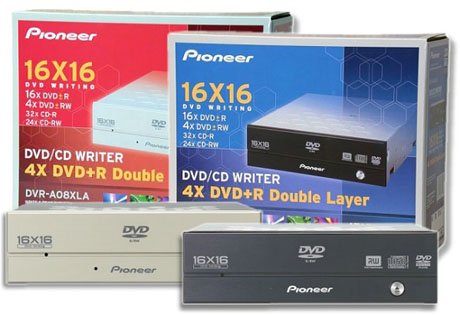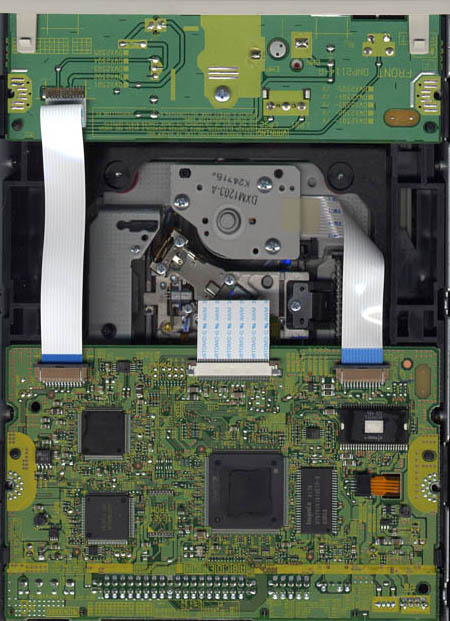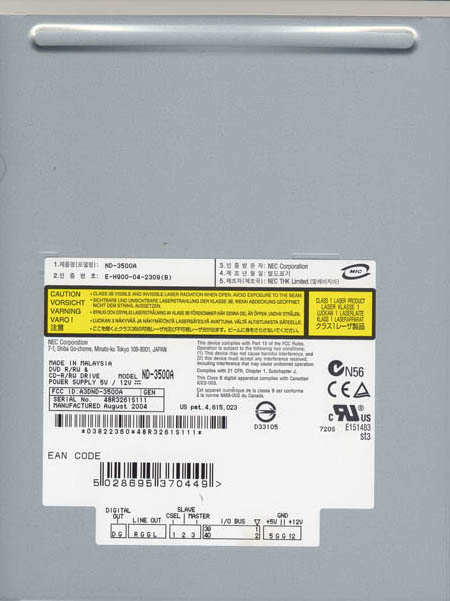
Original Link: https://www.anandtech.com/show/1528
Fall 2004 DVDR Roundup: Dual Layer and 16X DVD+R
by Anand Shimpi & Virginia Lee on November 1, 2004 12:05 AM EST- Posted in
- Storage
Introduction
How much faster will optical drives get? CD-ROM drives and CD burners topped out at 52X after years of jumping up the ladder from the original 1X speeds, and it seems as though DVD-ROM drives and DVD burners are following the same path; obviously, there is a trend here. Beginning at 1X, then raising the bar to 2X/2.4X just like the old days of CD burners, DVD drives have made it to 16X speeds in only a matter of a few years, thanks to the research that the big name companies performed during the compact disc hype. Two competing standards probably don't hurt acceleration development either.Before the world takes on the newly-forming standards for high definition discs, like Blu-Ray and HD-DVDs, the life of current 4.5GB/9GB DVDs still has a ways to go. Current audio/video content does not have a high demand for storage space and since there is only a small amount of hardware that can play high definition video, current 4.5GB/9GB DVDs will suffice for a while. Backwards compatible HD-DVD drives are already slated for deployment next year, and Blu-Ray isn't far behind either, but those standards will take a while to be fully adopted. So, we continue our quest to push the limits of current technologies in use today.
Back in August, we looked at Pioneer's 16X burner, the DVR-108D, and compared its performance to that of Plextor's 12X PX-712A, not as a fair competition, because obviously they are of different speeds, but rather as a general measure of how much faster 16X burners are compared to their 12X predecessors. The DVR-108D performed extremely well and carried great features like Dual Layer +R read/write and DVD-RAM read capabilities. Dual layer writing capabilities have become a standard in newer DVD burners. If there is a 16X burner introduced, it had better have the ability to write to a dual layer disc with at least 2.4X speeds, or it most likely won't make it in the market. Many of the big name manufacturers are seeing this as a standard and will not put a stripped down drive in stores for that reason. Other features such as a PI/PO read back ability as well as the newly-introduced bitsetting feature, which we will explain in a bit more detail later, are becoming just as popular as the dual layer feature.
We had mentioned before that as soon as we got our hands on more 16X models from various manufacturers, we would compare each drive's performance, and we have done just that. We pitted Pioneer's DVR-108D against BenQ's DW1620, MSI's DR16-B, NEC's ND-3500AG, Sony's DRU-710A, NuTech DDW-163, LG GSA-4160B and LiteOn's SHOW-1633 to see which unit will rule them all!
Picking the Right Drive
When we first started looking at DVD recorders, there were only two reference designs out there, and they supported different DVD formats. Ricoh took a backseat for about a year and competition from NEC, Sanyo, Hitachi, Philips and MediaTek began to heat up while virtually removing the format barrier (read up more about Ricoh on the NuTech page). The single layer format wars are largely over without incident - with some exceptions. Those who bought Ricoh-based drives and were promised additional media support and faster firmware upgrades still hold memories of getting burned (pun intended). What about all those countless drives that would perform exceptionally on only one brand of media? It isn't just one set of recording manufacturers who have poor track records; they all have dark spots on a relatively short industry life. Our objective is to decide which one of these drives in our analysis performs the best for the price, so that no one gets burned.How can we determine what the best performance of a recorder is? Although we largely compare one unit to another, the process is entirely quantitative - there is a systematic method to determining the best drive. Price, write quality, write speed, read quality, read speed, media support and feature support gauge the performance of our burners. Here is a checklist on how to pick the right burner.
Price: Perhaps one of the strongest weighted elements to evaluate, we want to know if the price makes sense. Two years ago, paying several hundred dollars for a DVD burner made sense. Paying over $100 today for a burner seems a little silly, even if performance is really outstanding. We have enough competition from several competing designs and dozens of manufacturers.
Write Speed: All of our burners burn at 16X, or do they? Looking at the average write speed of a burn is important to us, but mostly, it is just to let us know if a burner is doing something that it shouldn't. A 5-second difference between two burn speeds does not constitute a design win, but one drive writing twice as fast to another drive does.
Write Quality: The most important quantitative analysis that we do today is the write quality. As we mentioned before, no drive today will burn a DVDR significantly faster than another (with some exceptions), although perhaps the ones that do are doing it wrong. A burner that burns a disc with no errors (rather than a burner that burns a disc 5 seconds faster yet unreadable) constitutes a design win.
Read Speed, Read Quality: Probably the least weighted element in a DVD purchase. Obviously, a DVD recorder that can't read discs, or reads them improperly is a problem, but that flaw occurs extremely infrequently. Seek times and read quality both fall in this category.
Media Support: Choosing the right burner and choosing the right media are hand in hand with each other. The DVDR audience has been well trained to recognize the differences in media due to "the format wars", and those buying their second and third DVD burners tend to buy a burner for a type of media that they use. Now that the market is a little more mature, we are starting to see differences in each individual media brand. Ritek, Mitsubishi, Yuden, and CMC all have significant differences between each other, and some tend to burn faster and cleaner than others. Most of our examinations are limited to Ritek and Mitsubishi media, only because of the volume of testing needed to be done. The DVDR industry has shifted into the hands of the media manufacturers; even though a drive may promise a write speed for a particular format, if the drive's firmware team isn't working with all of the media outlets, then said drive will never perform correctly.
Another trend that we notice in media support can be generalized in maturity. Retail drive manufacturers who OEM the drive out to other manufacturers have the best media support. By OEM (original equipment manufacturer), we mean the manufacturer who produces the drive for a brand, but also sells under their own name. Most optical storage devices have a single programmer working on firmware for their drives; they only modify the OEM firmware by changing the name inside the drive BIOS - and sometimes not even that! The firmware teams are adding new media support and write descriptors. Write descriptors are the basic, low level operations that tell the burner exactly what to do, to write at a certain speed to a certain media. Generic write descriptors exist for all media, but performance comes from finely crafted write descriptors for a media speed and brand. Thus, manufacturing teams with large or talented firmware teams tend to perform better than ones who do not have such teams.
Determining if a drive can provide the best media support is extremely difficult to ascertain, but knowing that a drive supports the major write descriptors correctly is the best step in the correct direction.
Other Features: Booktype capabilities, Mount Rainier and error feedback are also important options to consider when choosing a drive. Most of these features have declined significantly in importance over the last few years, but some people place their entire purchase decision on booktype options. If you've never heard of booktypes before, you probably don't fall into that category. Setting a booktype (bitsetting) is just the process of telling your burner to convert a DVD+R disc "virtually" into a DVD-ROM instead. This feature is important for some people who have older set-top DVD players that cannot recognize the "bit" that determines what type of DVD media is sitting in the drive. You can check out how this works in more detail in an older article of ours.
As we already briefly mentioned, the format wars are in passing. Although the debate between +R and - R format seems to rage in various enthusiast circles, +R seems to be winning in terms of market penetration and speed. The DVD-R consortium does not have a dual layer, nor 16X media available yet, and they have been playing catch up for almost two years now.
The Test
We have decided to change the format slightly for this edition of our optical storage roundup. DVD recorders are a lot like graphics cards in some respects; we can simply analyze which burners give us the fastest burn and read speeds, but that is only half of the picture. The other half of any optical storage analysis is the write and read quality. Although many burners have no problems burning a disc at 12X or 16X, reading them back (even in the same drive) doesn't work! Furthermore, if a burner only happens to write and read correctly on one particular type of media, we cannot recommend that as a stable, worthwhile product.Thus, we attempted to answer these questions in a multipart analysis of many different types of media. First, we take the subject drive and write samples of test discs to several different media types. In the US, it is only common to see a few different types of DVDR media, almost all of which we have been tested in our analysis. We go out to retail stores before all of our analyses and buy media for the review. Almost all of our media is store-bought unless stated otherwise. The record speeds of all of these media are noted and displayed near the end of the analysis. We read the disc back in the same drive to make sure it wrote correctly. This read speed is also noted and placed into a chart at the end of our review.
After creating all of these media, we have to determine if they are useful or not. We read the media back in our highly recommended 12X Plextor PX-712A drive. This drive has the additional capability of reading back error data (our MediaTek drives also have this feature). Coupled with the Q-Tools software bundled with Plextor burners, we do two things: read the disc back to make sure it burned correctly, and use Q-Tools to determine how many errors the disc had. Both the read speed and the number of various errors are recorded and charted near the end of the analysis.
Since we record so much data, there are a lot of various graphs that need interpreting. Below is the graph of a poor write of one of our burners, with an explanation of what all the signs mean.
You'll notice that the yellow line on the bottom is the speed of rotation as the disc spins. The green line on the top denotes how fast the disc is being written or read at. Generally, we look for spikes in the graph. Harsh spikes during a read generally indicate that the disc has a poor sector, and the burner is calibrating itself slower to read that particular segment better. Harsh spikes during a read may also indicate a poorly written sector; many burners calibrate speed down when they are starting to loose control of the burn. The exception to this is usually when a write spikes up and stays there - this indicates that the burner can write at a faster speed and is calibrating itself (usually in a step pattern) to do so. Drives that produce a lot of errors won't read back correctly - or at all.
After reading the disc, we run a test that actually counts the number of errors in the Q-Tools software from Plextor. A screenshot of what this software looks like is below.
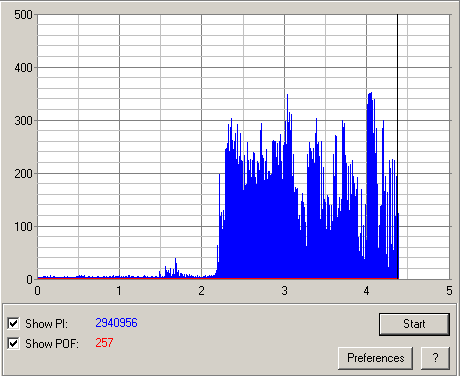
Here, we see a disc with a moderate number of errors. DVDs use the Reed-Solomon error correction algorithm that allows the drive to detect/correct errors. For DVDs, the graphs indicate parity errors. Although, the PO (parity outer) errors reported by Q-Tools generally refer to uncorrectable errors that will most likely render the disc unreadable if they exist in the double digits. PI errors are generally correctable errors, which are mainly troublesome when there are a large number of them. A disc with a few hundred PI errors is close to a "perfect" while one with a PI error count upwards towards a few hundred thousand general means the entire burn was horrible. These PI errors could result from low quality media with shallow scratches or, more often, a burner with bad media compatibility. Usually firmware updates can fix these issues.
Pioneer DVR-108D
We took our first look at the Pioneer 108D under the official US firmware (at the time) back in August. Since then, we retested the drive with lots of new media and a newer firmware. Pioneer and NEC arguably share the title of most mature 16X solutions available - both drives have been available for three months now.Below, you can see the individual specifications of the drive.
| Pioneer DVR-108D 16x DVD-/+RW Drive | |
| Interface | PATA |
| CD Write Speed | 32X, 24X ZCLV 16X, 8X, 4X CLV |
| CD Rewrite Speed | 24X ZCLV 16X, 10X, 4X CLV |
| CD Read Speed | 40X MAX CAV |
| DVD-R Write Speed | 16X, 12X, 8X CLV 4X, 2X, 1X |
| DVD-RW Rewrite Speed | 4X, 2X, 1X CLV |
| DVD+R Write Speed | 16X, 12X, 8X ZCLV 4X, 2.4X |
| DVD+RW Rewrite Speed | 4X, 2.4X CLV |
| DVD+DL Write Speed | 2.4X CLV |
| DVD-RAM Read Speed | 2X CLV |
| DVD Read Speed | 16X MAX CAV |
| Supported Modes | DAO / DAO-RAW 16 & 96 TAO SAO / RAW SAO, RAW SAO 16 & 96 Packet Write Multi-Session |
| Supported Formats | DVD+R (DAO, incremental, seq) DVD+RW (random) DVD-R (DAO, incremental, seq) DVD-RW (restricted overwrite) CD-R, CD-RW, CD-ROM, CD-DA, Mixed Mode, CD Extra Photo CD, CD Text, Bootable CD, UDF |
| Access Time | CD: 130ms DVD: 140ms |
| Buffer | 2MB |
Since Pioneer is our definitive 16X recorder that we have already reviewed, we are comparing all of our specifications against it. The most disappointing aspect of the drive that we have noticed during our analysis over these last few weeks has been the (relatively) slow CDR burn speeds. DVDR burn speeds are excellent, and the drive technically supports 4X DVD+DL burn speeds, even though it does not readily advertise such. You can see our original DL tests on the drive here.
Retail versions of the drive come with a redesigned bezel look. For the OEM version that we obtained for the review, the bezel retains the same bland pale design seen in the Pioneer 107 and 106D (and its derivatives).
The drive is recognized in Nero's Infotool as such:
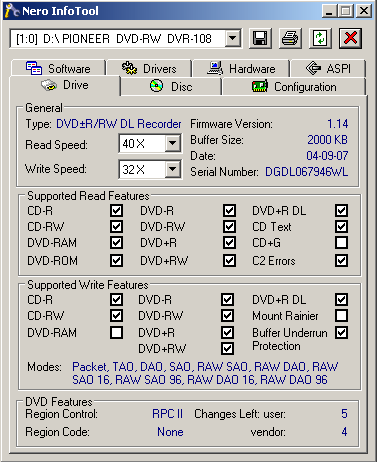
Here's a high resolution scan of the topside of the DVR-108D showing off its label.
Below, you can see another high resolution scan of the drive's internal components.
Our drive came with the NEC D63635GM and C3335 chipsets featuring Hynix DRAM. NEC's D63635 digital signal processor (DSP) was the first to 16X, and thus far, has a very stable track record. Keep in mind, even though the NEC 3500A and the Pioneer 108D utilize the same controllers and servos, they are designed and built completely different. NEC's design revolves around a single double-sided PCB with differing flash/DRAM solutions. The Pioneer drive also supports reading of DVD-RAM media at 5X speeds. There are many similarities between the drives, such as the multi-chip analog controller approach.
A few other drives on the market, like the ASUS DRW-1604P, are built on the same design and chipset, and generally offer identical performance. However, the Pioneer 108D has the most mature firmware and reference design; its performance should equal or surpass other models on the same platform.
Feel free to download the performance graphs for the DVR-108D here.
NEC ND-3500A
Pioneer's strongest competitor, the NEC 3500A, is a drive for which we have strong expectations. NEC's non-existent retail channel makes buying the drive a hassle - but you can easily find it at online retailers.| NEC ND-3500A 16X DVD-/+RW Drive | |
| Interface | PATA |
| CD Write Speed | 48X, 40X, 32X, 24X ZCLV 16X, 8X, 4X CLV |
| CD Rewrite Speed | 24X ZCLV 16X, 10X, 4X CLV |
| CD Read Speed | 40X MAX CAV |
| DVD-R Write Speed | 16X, 12X, 8X CLV 4X, 2X, 1X |
| DVD-RW Rewrite Speed | 4X, 2X, 1X CLV |
| DVD+R Write Speed | 16X, 12X, 8X ZCLV 4X, 2.4X |
| DVD+RW Rewrite Speed | 4X, 2.4X CLV |
| DVD+DL Write Speed | 2.4X CLV |
| DVD-RAM Read Speed | 2X CLV |
| DVD Read Speed | 16X MAX CAV |
| Supported Modes | DAO / DAO-RAW 16 & 96 TAO SAO / RAW SAO, RAW SAO 16 & 96 Packet Write Multi-Session |
| Supported Formats | DVD+R (DAO, incremental, seq) DVD+RW (random) DVD-R (DAO, incremental, seq) DVD-RW (restricted overwrite) CD-R, CD-RW, CD-ROM, CD-DA, Mixed Mode, CD Extra Photo CD, CD Text, Bootable CD, UDF |
| Access Time | CD: 130ms DVD: 140ms |
| Buffer | 2MB |
As we mentioned earlier, NEC's 3500A looks very similar to the Pioneer DVR-108D, and they should - they have very similar components. Most notably, however, the NEC 3500A advertises much higher CD write speed (48X as opposed to 32X). We noted earlier that write quality trumps write speed, but write speed in this instance is quite significant.
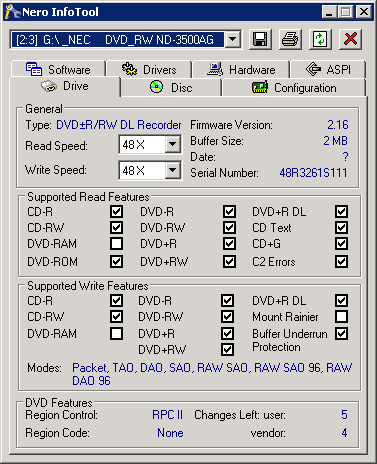
A snapshot of Nero's InfoTool shows the supported read and write features of the ND-3500A. We expected the 3500A to support the ability to read DVD-RAM media, but the unchecked box next to it told us something different.
A high resolution scan shows the 3500A's NEC chipset. As we mentioned before, the 108D uses the same chipset, the NEC D63635 DSP, and it is disappointing to learn that the 3500A as a drive does not readily support the feature. Both the 3500A and the 108D support 16X burning of DVD+R media as well as 48X CDR reading/writing capabilities.
A high resolution scan of the topside label:
Feel free to download the performance graphs for the ND-3500A here.
BenQ DW1620
We took our first look at the BenQ 16X drive just a few weeks ago. Our second look at the DW1620 uses the same firmware, although we were able to get some better media.| BenQ DW1620 16x DVD-/+RW Drive | |
| Interface | PATA |
| CD Write Speed | 40X, 32X, 24X CAV 16X, 8X, 4X CLV |
| CD Rewrite Speed | 24X ZCLV 16X, 10X, 4X CLV |
| CD Read Speed | 40X MAX CAV |
| DVD-R Write Speed | 16X, 12X, 8X CAV 4X, 2X, 1X |
| DVD-RW Rewrite Speed | 4X, 2X, 1X CLV |
| DVD+R Write Speed | 16X, 12X, 8X CAV 4X, 2.4X |
| DVD+RW Rewrite Speed | 4X, 2.4X CLV |
| DVD+DL Write Speed | 2.4X CLV |
| DVD Read Speed | 16X MAX CAV |
| Supported Modes | DAO / DAO-RAW 16 & 96 TAO SAO / RAW SAO, RAW SAO 16 & 96 Packet Write Multi-Session |
| Supported Formats | DVD+R (DAO, incremental, seq) DVD+RW (random) DVD-R (DAO, incremental, seq) DVD-RW (restricted overwrite) CD-R, CD-RW, CD-ROM, CD-DA, Mixed Mode, CD Extra Photo CD, CD Text, Bootable CD, UDF |
| Access Time | CD: 120ms DVD: 120ms |
| Buffer | 2MB |
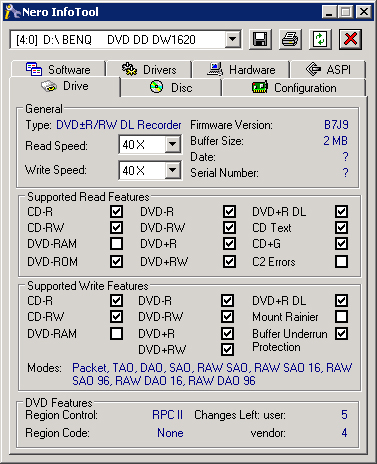
Our first test burns with the DW1620 made us a bit nervous. The drive seemed to jump quite a bit during the writing process and we didn't hesitate to contact BenQ about it. They, in turn, informed us of their "Write right technologies" and reassured us that this behavior was normal for the drive. Their "Write right technologies" are a combination of features including Walking Optimal Power Control II (WOPC II), which adjusts the power of the laser during the burning process to ensure a quality burn.
One cause of "errored" burns is a warped area on the surface of the disc. For a drive to optimally write to media, the laser must be at a 90 degree angle to the surface of the media, which is where BenQ's tilt control feature comes into play. By scanning the physical surface of the warped media and tilting the laser, the drive can both read and write to warped media where other drives would produce errors. The Block Error Rate Optimal Writing Control (BLER OPC) helps the burner perform better at the end of the disc, since that is where the most errors can occur due to warped media surfaces.
Another feature that is said to help the DW1620 read and write to media much more efficiently than other drives is its sliding cone, which helps support the media when clamped in the drive and provides for quicker and more efficient auto-centering of the media on the drive's turntable. Features like these are not advertised on most all of the other drives but they are still successful at reading and writing. We will see if these technologies actually help the DW1620 when we perform our benchmarks.
The DW1620 is based on the Philips Nexperia PNX7860E chipset, which works in conjunction with the TZA1047 analog processor to facilitate 16X DVD-/+R writing speeds as well as DVD+R DL writing capabilities.
A scan of the DW1620's label:
Feel free to download the performance graphs for the DW1620 here.
MSI DR16-B
MSI's still reigns as the largest OEM optical storage manufacturer, although much of that business is heavily dependent on CDRW drives and not necessarily recorders.| MSI DR16-B 16X DVD-/+RW Drive | |
| Interface | PATA |
| CD Write Speed | 40X, 32X, 24X CAV 16X, 8X, 4X CLV |
| CD Rewrite Speed | 24X ZCLV 16X, 10X, 4X CLV |
| CD Read Speed | 40X MAX CAV |
| DVD-R Write Speed | 16X, 12X, 8X CAV 4X, 2X, 1X |
| DVD-RW Rewrite Speed | 4X, 2X, 1X CLV |
| DVD+R Write Speed | 16X, 12X, 8X CAV 4X, 2.4X |
| DVD+RW Rewrite Speed | 4X, 2.4X CLV |
| DVD+DL Write Speed | 2.4X CLV |
| DVD Read Speed | 16X MAX CAV |
| Supported Modes | DAO / DAO-RAW 16 & 96 TAO SAO / RAW SAO, RAW SAO 16 & 96 Packet Write Multi-Session |
| Supported Formats | DVD+R (DAO, incremental, seq) DVD+RW (random) DVD-R (DAO, incremental, seq) DVD-RW (restricted overwrite) CD-R, CD-RW, CD-ROM, CD-DA, Mixed Mode, CD Extra Photo CD, CD Text, Bootable CD, UDF |
| Access Time | CD: 120ms DVD: 120ms |
| Buffer | 2MB |
Specifications for this drive are right in the middle of the pack. There is nothing neither exceptional nor poor about the table above.

Other MSI designs in the past have revolved around Sanyo chipsets, and we were somewhat hoping for another one when we obtained the DR-16B. The MSI burner had us a little worried the first time we opened it up. Not only does it look identical to the NuTech DDW-162 and the BenQ DW1620, they even have the same QA approval stickers on them!
Make no mistake about it - the NuTech, BenQ and MSI drives are virtually identical with the exception of price and firmware. Referring back to the second page of this article, we may already start to suspect that whichever one of these drives is closest to the OEM manufacturer is likely the one with the better firmware/write descriptors.
Feel free to download the performance graphs for the DR16-B here.
LiteOn SOHW-1633S
Our roundup would not be complete without an offering from LiteOn. LiteOn has continuously proven itself as a solid (but generally not outstanding) OEM and retail manufacturer.| LiteOn SHOW-1633S 16X DVD-/+RW Drive | |
| Interface | PATA |
| CD Write Speed | 48X, 40X CAV 32X, 24X P-CAV 16X, 8X CLV |
| CD Rewrite Speed | 24X Z-CLV 16X, 10X, 4X CLV |
| CD Read Speed | 40X MAX CAV |
| DVD-R Write Speed | 8X, 6X Z-CLV 4X, 2X, 1X |
| DVD-RW Rewrite Speed | 4X, 2X, 1X CLV |
| DVD+R Write Speed | 16X CAV 12X, 8X P-CAV 6X, 4X, 2.4X |
| DVD+RW Rewrite Speed | 4X, 2.4X |
| DVD+DL Write Speed | 2.4X CLV |
| DVD Read Speed | 16X MAX CAV |
| Supported Modes | DAO / DAO-RAW 16 & 96 TAO SAO / RAW SAO, RAW SAO 16 & 96 Packet Write Multi-Session |
| Supported Formats | DVD±R/W (DAO, Incremental, muti-border, restricted overwriting) CD-R, CD-RW, CD-ROM, CD-DA, (variable packet, TAO, SAO, DAO, raw burning/overburn) |
| Access Time | CD: 160ms DVD: 160ms |
| Buffer | 2MB |
Once again, LiteOn went with a MediaTek based DSP, the MT1828E. Below, you can see a scan of the double-sided PCB. Using a PCB with components on both sides slightly increases the cost and complexity of the unit, but also decreases the size of the drive. This is why most MediaTek burners have a smaller form factor.
On the front side of the mainboard, there is not a whole lot to see other than the Samsung 3.3V DRAM module. The reverse side of the main PCB can be seen below.
Coupled with the analog controller, the MT1616E, the SHOW-1633S provides all the features of NEC and Pioneer, as well as additional features like error feedback. All MediaTek controllers provide feedback to the PC on the number of C1/C2/C3 (or PI/PO) errors produced during a burn. Software like K-Probe allows the PC to record and graph these errors in the same manner that Q-Tools reports errors. This is a great feature if you are a hardware reviewer, but not something that we would recommend as a factor in a purchase decision.

Although we are accustomed to high pitch whines while writing discs, the LiteOn 1633S was extremely noisy.
Feel free to download the performance graphs for the SOHW-1633S here.
Sony DRU-710A
Sony has produced some very intriguing products over the last few years, particularly since the DVDR format wars started to really heat up. Sony generally takes the most competent recording platform and then rebrands it while working with the original OEM to improve the firmware and write descriptors. The last several iterations of Sony burners are based on LiteOn OEM designs, and the DRU-710A is no exception either.Up until recently, Sony actually had two product lines: a high speed, single layer line (DRU-5Xx) and a slower, dual layer line (DRU-700). Now that dual layer burners are synonymous with 16X burners, the 5Xx line has slightly given way to the 7Xx series instead.
| Sony DRU-710A 16X DVD-/+RW Drive | |
| Interface | PATA |
| CD Write Speed | 48X CAV 40X, 24X, 16X, 8X P-CAV |
| CD Rewrite Speed | 24X, 16X, 10X, 4X Z-CLV |
| CD Read Speed | 40X MAX CAV |
| DVD-R Write Speed | 8X, 4X, 2X, 1X Z-CLV |
| DVD-RW Rewrite Speed | 4X, 2X, 1X CLV |
| DVD+R Write Speed | 16X CAV 12X, 8X, 4X, 2.4X P-CAV |
| DVD+RW Rewrite Speed | 4X, 2.4X |
| DVD+DL Write Speed | 2.4X |
| DVD Read Speed | 16X MAX |
| Supported Modes | DAO / DAO-RAW 16 & 96 TAO SAO / RAW SAO, RAW SAO 16 & 96 Packet Write Multi-Session |
| Supported Formats | DVD+R (DAO, incremental, seq) DVD+RW (random) DVD-R (DAO, incremental, seq) DVD-RW (restricted overwrite) CD-R, CD-RW, CD-ROM, CD-DA, Mixed Mode, CD Extra Photo CD, CD Text, Bootable CD, UDF |
| Access Time | CD: 145ms DVD: 135ms |
| Buffer | 2MB |
Just like our DRU-700, the DRU-710 supports booktype setting and error diagnostics from the MediaTek chipset. As you can see above, all of the specifications are identical between the DRU-710A and the LiteOn SOHW-1633.
Product support for Sony is top notch. We have dozens of great experiences when testing Sony's quality control, and their forums, help desk and live chat all surpass anything that the other drive manufacturers in this analysis are capable of.
Sony recorders are almost always the most expensive retail drives in our roundups, and that hurts them considerably in the price analysis. However, if you look for their OEM models in places like NewEgg, you can find much cheaper drives without software.

Like the LiteOn counterpart, the Sony DRU-710A was also extremely noisy and emitted a high pitched whine during the entire burn.
Feel free to download the performance graphs for the DRU-710A here.
LG GSA-4160B
LG always sparks our attention, since they design and build one of the few truly universal DVD burners available. 5X DVD-RAM support is an enormous addition to the DVD-RAM community, and the GSA-4120B introduced in May was the only burner capable of high DVD-RAM speeds. Unfortunately, media then (and now) still seems to plague the DVD-RAM community, although that hasn't stopped LG from producing a tri-format recording solution.LG is completely unique in the sense that most of its components are designed around chipsets and servos exclusively used on LG-Hitachi burners. We don't see recorders with the same controllers for sale under different brand names, like we do with the Pioneer 108D (ASUS DRW-1604P) or the NEC 3500A.
| LG GSA-4160B 16X DVD-/+RW Drive | |
| Interface | PATA |
| CD Write Speed | 40X, 24X 16X, 8X, 4X |
| CD Rewrite Speed | 24X, 16X, 10X, 4X |
| CD Read Speed | 40X MAX |
| DVD-R Write Speed | 8X, 6X, 4X, 2X, 1X |
| DVD-RW Rewrite Speed | 4X, 2X, 1X |
| DVD+R Write Speed | 16X, 12X, 8X 4X, 2.4X |
| DVD+RW Rewrite Speed | 4X, 2.4X |
| DVD+RAM Write Speed | 5X, 3X, 2X |
| DVD+DL Write Speed | 2.4X |
| DVD Read Speed | 16X MAX (ROM) 8X MAX (-/+R, -/+RW) 5X MAX (RAM) |
| Supported Modes | DAO / DAO-RAW 16 & 96 TAO SAO / RAW SAO, RAW SAO 16 & 96 Packet Write Multi-Session |
| Supported Formats | DVD+R (DAO, incremental, seq) DVD+RW (random) DVD-R (DAO, incremental, seq) DVD-RW (restricted overwrite) CD-R, CD-RW, CD-ROM, CD-DA, Mixed Mode, CD Extra Photo CD, CD Text, Bootable CD, UDF |
| Access Time | CD: 125ms DVD: 145ms DVD-RAM: 165ms |
| Buffer | 2MB |
Even though the GSA-4160B has slower DVD-R write speeds than most of the other drives in our roundup, the ability to write DVD-RAM discs sets it apart from all of our other burners. DVD readers are starting to adopt DVD-RAM reading much better than they have in the past. So, if you can find DVD-RAM media for cheap, it certainly makes an attractive feature addition.
Unlike most of our other DVD recorders in the roundup, the GSA-4160B does not advertise 16X DVD-R write speeds. Although, we question how necessarily relevant that specification is, since no 16X DVD-R media exists yet anyway. Below, you can see what Infotools reports:

Inside, our GSA-4160B looks identical to the GSA-4120B, all the way down to the SKUs on the chips itself.
The flash memory located on the left side of the PCB appears to be the only major change. You may recall that our older GSA-4120B utilized a 2MB Fujitsu flash solution, while the GSA-4160B incorporates a Macronix MX29LV160BT TSOP instead. The performance advancements in this drive almost certainly come from the more mature firmware, rather than newer components.
We had positive feelings for the GSA-4120B, and if LG-Hitachi corrected some of the minor write strategy issues while adding 16X DVD+R write capability, this drive will give all of the top tier manufacturers a run for its money.
Feel free to download the performance graphs for the GSA-4160B here.
NuTech DDW-163
Taiwanese NuTech (Quanta's retail channel) surprised us all a little with their DDW-081/082 drives. They were great for the price and deserved our Editor's Choice Award back when 8X was the best speeds that you could obtain on a DVD recorder.However, things have changed a lot since six months ago when we conducted that roundup. Most contenders in the optical storage sector continued to improve and refine their write descriptors and firmware while NuTech stayed relatively quiet. The DDW-163 never received a full fledged press release and just began to trickle onto the online marketplaces this week.
| NuTech DDW-163 16X DVD-/+RW Drive | |
| Interface | PATA |
| CD Write Speed | 40X, 32X, 24X 16X, 8X, 4X |
| CD Rewrite Speed | 24X, 16X, 10X, 8X, 4X |
| CD Read Speed | 40X MAX |
| DVD-R Write Speed | 8X, 4X, 2X |
| DVD-RW Rewrite Speed | 4X, 2X, 1X |
| DVD+R Write Speed | 16X, 8X 4X, 2.4X |
| DVD+RW Rewrite Speed | 4X, 2.4X |
| DVD+DL Write Speed | 2.4X |
| DVD Read Speed | 16X MAX (ROM) 10X MAX (-/+R, -/+RW) 5X MAX (RAM) |
| Supported Modes | DAO / DAO-RAW 16 & 96 TAO SAO / RAW SAO, RAW SAO 16 & 96 Packet Write Multi-Session |
| Supported Formats | DVD+R (DAO, incremental, seq) DVD+RW (random) DVD-R (DAO, incremental, seq) DVD-RW (restricted overwrite) CD-R, CD-RW, CD-ROM, CD-DA, Mixed Mode, CD Extra Photo CD, CD Text, Bootable CD, UDF |
| Access Time | CD: 125ms DVD: 145ms |
| Buffer | 2MB |
Nothing stands out here as particularly dramatic. Why all the secrecy around the newest NuTech drives? Remember our sneak peak at upcoming OSD devices during Computex 2004, particularly about Ricoh's reemergence back into the DVDR chipset arena? The NuTech DDW-162 drive was one of those slated to use the new Ricoh chipset. But today, we are looking at the DDW-163 instead. It would appear as though that, instead of pursuing a Ricoh design, NuTech scrapped the idea and continued to evolve their DDW-082 with the Nexperia chipset. In fact, even though we saw several of slated burners for the Ricoh chipset at Computex, not one of our burners today employs those chips. Ricoh may still introduce a product based on their core logic, but its getting a little late in the game.
Below, you can see what Infotool had to say about the Philips Nexperia based DDW-163.

Internally, a lot seems to have changed since the NuTech DDW-082/1. The DDW-163 uses the newest Nexperia 7860E core logic and the TZA1047HL analog processor. Like the LG GSA series, the NuTech DDW-162 uses flash memory as well.
NuTech has a very diverse product support team. Their employees are the ones who you see posting in forums and working on hacking their own firmware. Coaxing the Nexperia chipset into working with the DVD-R format on the DDW-082 was certainly not an easy task. Living on the fringe of product support and blurring the lines between customer feedback and company direction are extremely refreshing. By contrast, nearly faceless companies like Pioneer and NEC approach customer influence on more traditional marketing channels.
The Nexperia chipset is somewhat of a late-bloomer in the 16X market. If NuTech can keep their QA up, they can definitely utilize this chipset to its fullest by providing quality firmware updates.
Feel free to download the performance graphs for the DDW-163 here.
Read Tests/Seek Times
For our CD read and seek time tests, we used a CD-ROM filled with 700MB of data on all of the competitors.
Though the NEC ND-3500A had an excellent performance in CD and DVD read and write speeds and quality, the average CD seek time was the second longest compared to the rest of the drives at 125ms. Pioneer's DVR-108D averaged at about a 131ms seek time. The quickest drives were the DW1620 and MSI's DR16-B.
As for the DVD seek time tests we used a DVD-Video, specifically "The Matrix".

The results for DVD seek times were the same, with the Pioneer unit being the slowest at 134ms and Nu Tech's DDW-163 coming in at first at 94ms.
Now let's take a look at how quickly our drives could read a DVD in measures of read speed.

From our results, it is obvious once again that the ND-3500A reads not only CD media, but also DVD 4.5GB media, the fastest at an average of 11.05X. The slowest was Sony's DRU-710A, which reported an average 6.13X speeds. How will the ND-3500A perform with 9GB DVD media?
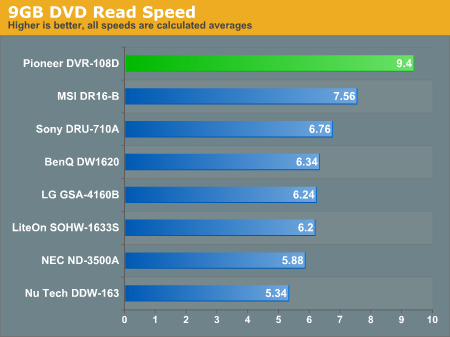
There has been quite a bit of change from 4.5GB DVD read speeds. With a 9GB DVD, the Pioneer DVR-108D comes out on top at an average read speed of 9.40X while, surprisingly, MSI's DR16-B comes in second at 7.56X on average. The NEC does not do as well this time, coming in second to last with a 5.88X read speed, slightly better than the last place Nu Tech DDW-163's 5.34X average speed.
Write Tests
How else would we gauge a group of DVD burners if not by their write performance? We have compiled our results from the benchmarks that we have performed with a few types of media to which these drives are capable of writing.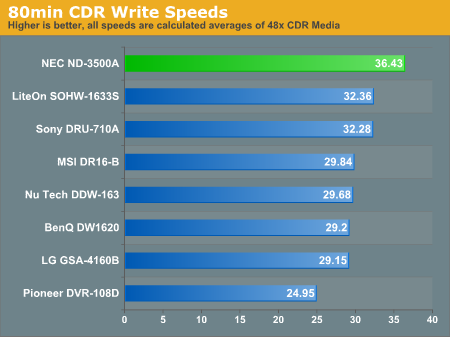
As we begin to move into the realm of DVDs, we tend to forget about how each DVD burner will handle CDR media. Our results show that all of the drives can burn CDR media above an average of 29X speeds with exception to the DVR-108D which averaged a 24.95X write. The NEC ND-3500A tops out at slightly above the 36X mark to take the CDR charts.
The focus of our 16X roundup ultimately hinges on DVD write speed and quality.
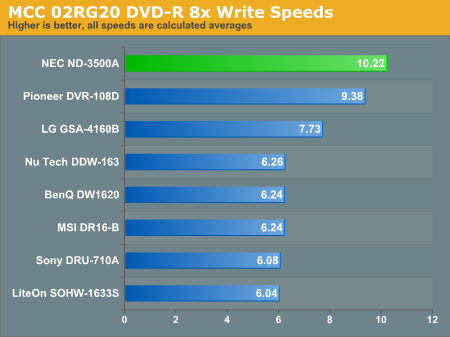
Here again, the ND-3500A tops the charts by writing to the Mitsubishi 8x DVD-R media at an average of 10.22x speeds. LiteOn is left behind at the end of the list with an average writing speed of 6.04x.
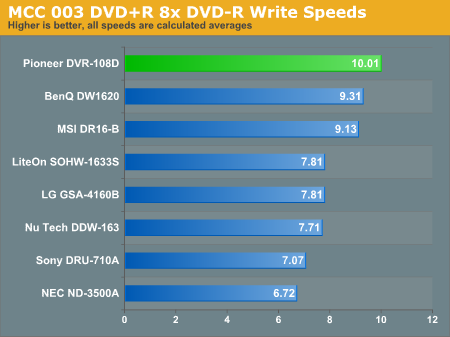
Pioneer has the MCC 003 media in its grasp as it burns a complete Mitsubishi DVD+R, which is rated at 8x speeds, at an average actual speed of 10.01X. Let's see how it does with the Ritek media.
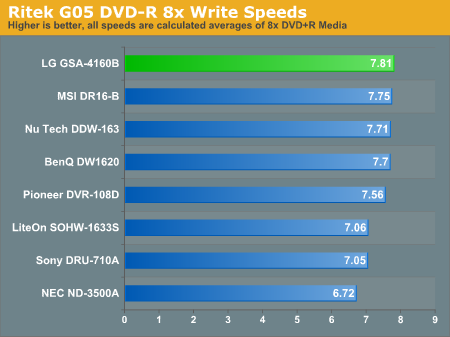
We expected the both the 108D and the ND-3500A to perform better on the Ritek media, but as the graphs show, they broke the 8x barrier, but not quickly enough to bring the average write speed above 8x. Sony's DRU-710A just barely made it to second to last while the first place position was taken, for this media, by LG's GSA-4160B at an average of 7.81X.
Write Tests (cont'd)
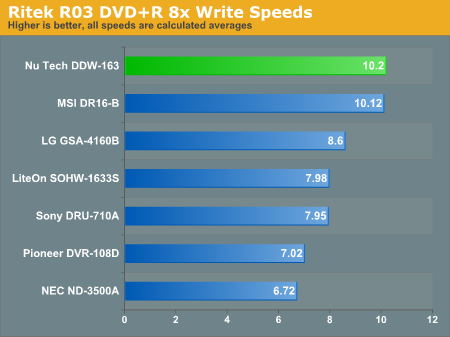
The DVR-108D, ND-3500A, and the GSA-4160B couldn't make it to the 8x mark as did most of the other drives. Though Ritek is one of the higher quality media like MCC, those drives still had some trouble working at the media's rated write speeds. The DDW-163 performed the best with the R03 media at 10.20X speeds while BenQ's DW1620 could not write to the disc at all.
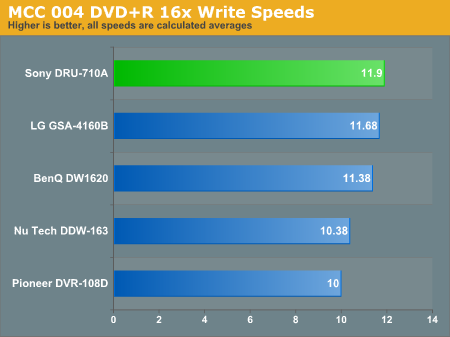
Sony's DRU-710A and BenQ's DW1620 were the only drives capable of writing to MCC 004 media at 16x speeds using the CAV write method. All other drives were either not capable of handling this media at the full 16x speed or choked on it from the beginning. The GSA-4160B made it to 14X but couldn't hold it until the end of the write and the 108D topped out at 12X with its Z-CLV method of writing.
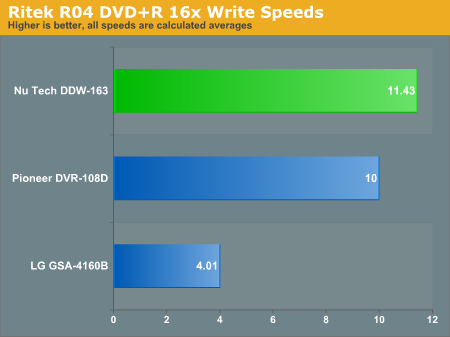
With the 16x Ritek media Nu Tech's DDW-163 was the only drive that would cooperate and push the speeds to 16x. All other drives either burned the 16x media at 4X or could not write to it at all. Ritek is not the largest MID available, but we were a little surprised to see so few burners actually capable of proper write descriptors. New firmware revisions will fix this issue in our other burners, but for the time being we were slightly dissapointed.

The only drives that burned coasters with dual layer media were Sony's DRU-710A and MSI's DR16-B. The rest all burned the dual layer media at around 2.4X while the DVR-108D and ND-3500A burned at about 4X speeds.
Write Quality Tests MCC 004
We read the 16X MCC 004 media in our Plextor drive with Q-Tools to check for errors that the various burners may have written. Again, only these drives were able to write to the 16X media properly for the PX712A to read.As we described in our second section, PO errors are the ones to look for when testing certain types of discs with burners. These errors can render a disc unreadable and should be minded if they exist in the double digits or even too often in a small area for them to be corrected. The media written with the four drives that we were able to read with Q-Tools were virtually PO error free.
Shown below are the results for those drives that were capable of writing to MCC 004 16X media successfully.
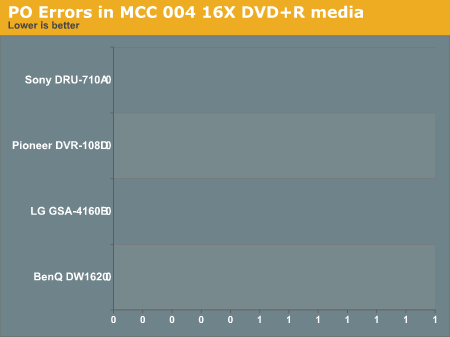
It is obvious that there were no problems writing readable discs with the Sony, LG, Pioneer, and Nu Tech drives.
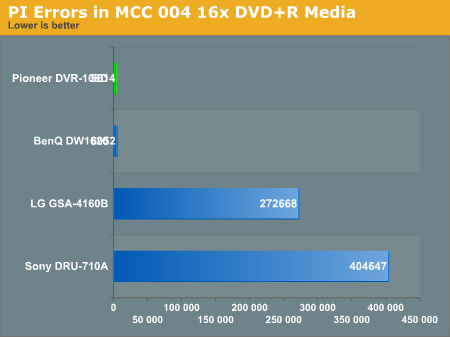
PI errors are not as ruthless as PO errors. For example, though Q-Tools has read 404,647 errors on the MCC 004 media written with the 710A, it doesn't mean that the disc is completely bad. Most of these errors were found towards the end of the disc, but data can still be read off that portion of the media.
 Click to enlarge. |
 Click to enlarge. |
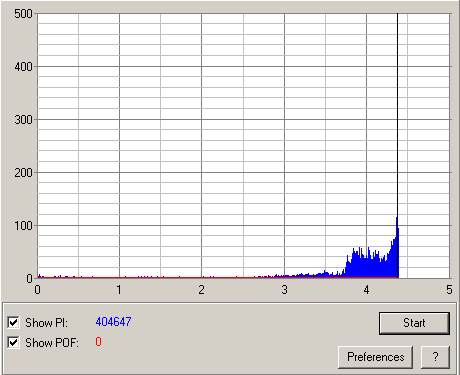 |
|
The screenshots above show that the DRU-710A has performed a successful write, but the read back on the Sony unit towards the end of the disc was a bit shaky. We mentioned earlier how media is prone to warping on the outer portions and this is where most of the errors can occur. Plextor Q-Tools confirms that by detecting over 400,000 PI errors within the last 1GB or so written to the MCC 004 disc. Take a look at the graphs from LG's GSA-4160B...
 Click to enlarge. |
 Click to enlarge. |
 |
|
Again, about 99.9% of the PI errors are at the end of the disc. The Nero screenshots show nothing in terms of trouble with writing or reading from the disc on the LG drive, mainly because it was able to correct these errors with ease.
The DW1620 and DVR-108D have done a better job at writing to the media with 6052 and 5614 PI errors respectively. We're disappointed that the other drives could not write to the MCC 004 media or could not be read with Q-Tools like the burn LiteOn's SOHW-1633S performed.
Write Quality Tests MCC 02RG20
The MCC 02RG20 media is the 8X Mitsubishi DVD-R media with which we benchmarked all of our drives.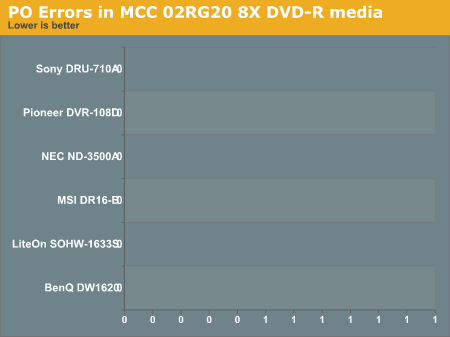
We still haven't encountered any errors that will render this media unreadable. Let's take a look at Q-Tool's results for the less problematic, yet plentiful, PI errors.

Though PI errors are not as irreparable as PO errors, the amount read on each of these discs says a lot about how the drives wrote to them. The DRU-710A had the most trouble writing to the -R media out of all of the drives that could. Also, PI errors increased as the write continued to the end of the disc, which we suspect was caused by the media being warped.
The screenshot below shows a scan of the media from the DRU-710A by Q-Tools. Again, the PI errors are in blue and it is obvious that the bulk of them reside in the second half of the disc, increasing as it reaches the end.
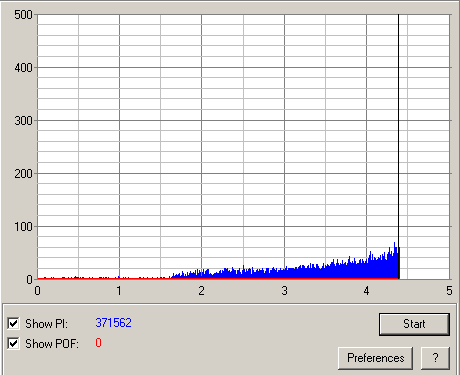
Another screenshot shows results from a Q-Tools scan of a 02RG20 disc written by the SOHW-1633S. Though the media did not have as many PI errors as the disc from the Sony drive, the same pattern showed up with errors increasing towards the end of the disc.

Write Quality Tests MKM 001
Dual layer media follows the same rules as single layer, but there are certain points on the disc where errors are known to occur the most. We have noticed that the part of the disc where the transition from layer to layer happens is where the PO errors have shown up. Our results are as follows: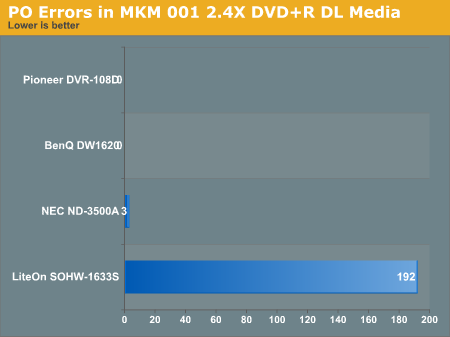
We didn't have much luck getting dual layer media both to burn on all drives, since the Sony DRU-710A and MSI DR16-B had trouble writing a successful dual layer disc, and if there was success, to be recognized on the Plextor drive. The DVR-108D and DW1620 came out clean with 0 PO errors each with NEC following with 3 PO errors. The SOHW-1633S was another drive we had luck with, but a successful write was the end of it. PO errors on the dual layer media from that drive hit 192 and were all located between the 2GB and 4GB mark where there were also a few million PI errors!
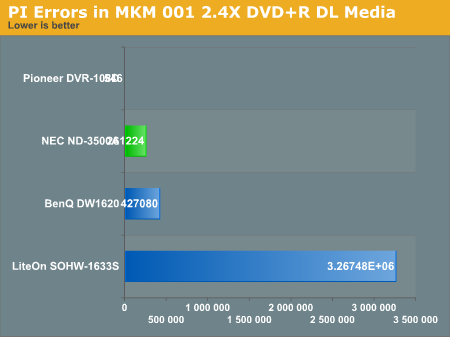
The DVR-108D performed exceptionally well producing on 546 PI errors on the MKM 001 media. NEC followed with 261224 PI errors which held it and the Pioneer unit at the top two spots.
The Q-Tools screenshot of LiteOn's burn shows the majority PI errors between the 2GB and 4GB range.
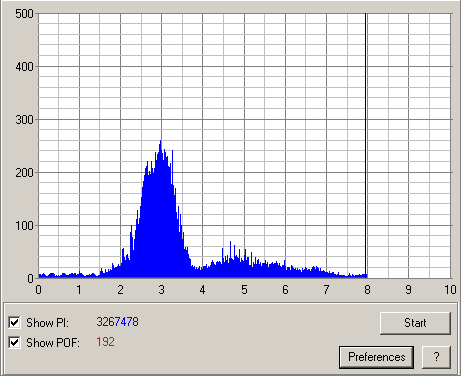
It's too bad that there were only 4 drives on which we could test write qualities. Hopefully, future firmware releases will fix compatibility issues on the drives that we have tested in order for media to be recognized correctly on a wider range of hardware.
Performance/Features Conclusion
Looking back to page two and three of this analysis, we wanted to give a quick reference chart to detail as much information as we could about the various burners in our roundup. Below, you can see how our burners performed under media in general. The DVD+R media listed is 16X MCC 004, the DVD-R media is 8X Ritek G05, DVD+DL media is 2.4X MKM 001, DVD-RAM media is Prodisc 3X, and CDR media is 48X Fujifilm.All speeds given as averages unless stated otherwise.
| Features Comparison | ||||||||
| Pioneer DVR-108D | NEC ND-3500A | BenQ DW1620 | MSI DR16-B | LiteOn SOHW-1633S | Sony DRU-710A | LG GSA-4160B | NuTech DDW-163 | |
| 80min CDR Read Speeds1 | 31.67 | 36.53 | 31.40 | 31.41 | 30.30 | 30.32 | 32.80 | 31.59 |
| 80min CDR Write Speeds1 | 24.95 | 36.43 | 29.20 | 29.84 | 32.36 | 32.28 | 29.15 | 29.68 |
| DVD-R Read Speeds2 | 9.38 | 11.88 | 6.25 | 6.25 | 7.72 | 6.09 | 7.73 | 6.26 |
| DVD-R Write Speeds2 | 10.01 | 10.22 | 9.31 | 9.13 | 7.81 | 7.07 | 7.81 | 7.71 |
| DVD+R 16X Read Speeds3 | 9.39 | 6.25 | 6.24 | 6.25 | 6.15 | 6.15 | 6.21 | 6.24 |
| DVD+R 16X Write Speeds3 | 10.00 | 12.03 | 11.38 | 10.46 | 11.90 | 11.90 | 11.24 | 10.38 |
| DVD+R DL Read Speeds4 | 5.70 | 3.40 | 6.04 | Coaster | 6.17 | Coaster | 6.17 | 6.02 |
| DVD+R DL Write Speeds4 | 4.00 | 4.13 | 2.35 | Coaster | 2.40 | Coaster | 2.41 | 2.34 |
| DVD-RAM Read Speeds5 | 1.95 | - | - | - | - | - | 3.01 | - |
| DVD-RAM Write Speeds5 | - | - | - | - | - | - | 1.43 | - |
| CD Seek Time in ms6 | 131 | 125 | 94 | 94 | 97 | 97 | 113 | 95 |
| DVD Seek Time in ms7 | 134 | 128 | 95 | 95 | 100 | 101 | 102 | 94 |
| Error Diagnostics | - | - | - | - | X | X | - | - |
| Booktype | Automatic | X | X | X | X | X | - | X |
| Chipset | NEC | NEC | Philips | Philips | MediaTek | MediaTek | LG-Hitachi | Philips |
2 8x 4.5GB MCC 02RG20 media
3 16x 4.5GB MCC 004 media
4 2.4x 8.5GB dual layer MKM 001 media
5 3x DVD-RAM Prodisc media
NEC's dominance of CDR burning came as no surprise. The Achilles heel of the Pioneer 108D is its CDR write speeds.
So, with all of the numbers that we have presented, what do they mean? Where does each of the eight 16X burners stand on the charts? As we presented on our chart above, there are a few drives that have the features and performance levels that put them towards the top. We mentioned earlier how Pioneer and NEC were the most matured drives, since they've been out for about 3 months now. Pioneer and NEC have had more time to test their drives with a long list of media, and have put out firmware updates to resolve some of the compatibility issues when first released while the manufacturers of the newer drives are just beginning to realize what works and what doesn't regarding compatible media.
For media compatibility, it is obvious that there are 3 units that come out on top: Pioneer's DVR-108, NEC's ND-3500A, and LG's GSA-4160B. All three units wrote to media of quality ranging from low to high in all formats including - R/RW, +R/RW, and +R DL.
It is obvious that performance is no problem for these 3 models, and what really makes them stand out from each other is their features. Seven out of the eight drives implemented the bit setting feature. We discussed earlier how setting the "Book Type" of the media increases its compatibility with set top DVD players. All three of our top competitors have this feature, but the 108D can only perform bitsetting automatically on DVD+R DL media. That knocks Pioneer's DVR-108D out of the race for the best burner, but keeps LG's GSA-4160B in the running for its DVD-RAM read/write capabilities. Pioneer may have stayed in the race for its DVD-RAM capabilities, if only it had write capabilities as well as it did read capabilities.
Finally, with the NEC ND-3500A and LG's GSA-4160B going head to head, we looked at the difference in features between the two and realized that the GSA-4160B's DVD-RAM read/write capabilities are not really useful in applications for the common end user. We feel the bitsetting function should take priority over DVD-RAM features, since it increases compatibility with set top boxes instead of creating another option to support. In the end, NEC's ND-3500A comes out on top to win the prize in both performance (fast read/write speeds, great quality of burns) and features (bitsetting, high DL write speeds). Though Pioneer's performance is just as impresseive, it is lagging behind in write speeds.
Pricing
We've tested various media from many different manufacturers to benchmark each drive's performance in reading and writing to see which unit performs the best overall, and we have come to the conclusion that LG's GSA-4160B has the features as well as the all around performance to put it close to #1 on our chart behind the NEC-3500A. That isn't the end of the story though. We need to factor in the cost of each drive to see if their performance matches their worth in dollars. We've searched around the web for retailers carrying each of these models and have come up with some figures. Note that the prices of 16X burners are steadily falling, so the numbers may differ at the time of publication of this review.Pioneer DVR-108
At $78, the DVR-108D is a great value. We saw in our benchmarks that Pioneer's drive performed as one of the best drives that we have tested. It had little to no trouble burning both high and low quality media in all flavors and kicked it into high gear, writing to 2.4X dual layer media at an average speed of 4.00X. The DVR-108D also performed well on - R media, writing at an average of 10.01X and reading it back at an average of 9.38X. More importantly, the quality of the writes was extraordinary. When read back on our Plextor drive with the PlexTools software, we encountered 0 PO errors on all of them.
NEC ND-3500A
As we mentioned earlier, the ND-3500A has taken the gold in read/write performance. It not only burned 2.4X DL media at an average of 4.13X like the DVR-108D, but again, even more important than the speed of the write, it burned each type and brand of media flawlessly. As we read each media back with PlexTools, we encountered only one problem with the Ritek 003 +R media. It seemed to be written perfectly, but both the NEC unit and the Plextor drive had trouble reading the disc back. Out of the 14 different types of media that we tested, though, one bad disc does not make much difference in the overall performance and quality of the drive. The ND-3500A is priced $10 lower than Pioneer's DVR-108D at $68 and features the bitsetting capability, which makes it the cheapest and best deal so far.
BenQ DW1620
BenQ's DW1620 had some trouble with a few types of media including Ritek's D01 DL media. It did handle Verbatim's MKM 001 DL media and single layer ( - R/RW, +R/RW) media well, writing to each with no PO errors as the PlexTools results showed. The price, however, does not seem to go with the drive's performance and features. The 1620 does not support DL burning at 4X like the ND-3500A and the DVR-108D, nor does it support DVD-RAM as does the LG GSA-4160B. At $90, the DW1620 is hardly a deal when there are other models that will outperform this unit in many areas.
MSI DR16-B
The DR16-B did an extremely good job of burning most of the single layer media that we threw at it. Unfortunately, it had a lot of trouble with any DL media that we tried to burn, including Ritek's and Verbatim's media. It could barely make it past the 2GB mark when creating a disc and obviously could not read it back. We hope that MSI releases a firmware update in the future to fix this problem; and currently, a $94 price tag does not fit this drive, especially when it is competing against the three mentioned above in performance as well as a price (that was as much as $12 lower). With a firmware fix for dual layer compatibility, the DR16-B could become one of the best drives on this list, and again, this model includes the bitsetting feature as do the DW1620 and the ND-3500A.
LiteOn SOHW-1633S
The LiteOn drive, the SOHW-1633S, did not live up to the level of performance of any of the other drives in this roundup. Its performance was about average; although it wrote to both the Ritek and Mitsubishi media as it was supposed to, performance ended there. The dual layer Burn quality was not as great as that of the DVR-108D or the ND-3500A, with PlexTools reporting 192 PO errors on the burned disc. For $73, the unit is worth the retailers' prices, but we recommend sticking to one of the top 3 that we mentioned in the previous section, for their quality in burns on all of the media.
Sony DRU-710A
The DRU-710A is identical to LiteOn's SOHW-1633S. Though the internals were the same, the price of the Sony, at $115, exceeded our estimates for the performance it put out. We had some trouble writing to DL media just as we did with the MSI DR16-B. We were surprised, since LiteOn's unit is completely identical to the Sony, in every way. The DRU-710A also had trouble reading lower quality media such as that from Platinum, VDSPMSAB 001 as well as AN31, both 4X media. They seemed to write fine at a steady 4X all the way through, but bottomed out towards the end of the disc. A PlexTools reading showed a little over 100 parity outer errors, which is enough to render a disc unreadable. And, we know it is not the media, since many of the other units produced much fewer errors.
LG GSA-4160B
Since LG has implemented DVD-RAM write and read capabilities into the GSA-4160B, it is worth the $85. The performance of this drive is not as great as the Pioneer or the NEC due to its slow DVD-R write speeds that we mentioned earlier, but competing with those manufacturers with all of the features that LG has implemented in the GSA-4160B, it is well worth its price. It averages 2.41X in writing to DL media and has one of the fastest DL read times, at an average of 6.17X. Even with the lower quality AN31 and VDSPMSAB 001 media, this LG model didn't produce one PO error. Though there was an issue with reading the 16X Ritek R04 media with the Plextor drive, it just didn't want to recognize the disc. The booktype setting feature offered in this unit also makes this a great drive. The GSA-4160B is a bit on the steep side when compared to that of the ND-3500A for its overall performance and feature list, but is still affordable and worth the price.
NU Tech DDW-163
NU Tech's DDW-163 is priced at around $70 and with its almost solid writing performance, it competes directly with LiteOn's SOHW-1633S. All but one media that we tested on this drive had successful write and read with Ritek R03 media, which is rated at 8X, topping out at 12x burn speeds. Unlike LG's GSA-4160B, the Ritek R04 16X media burned with the DDW-163 read perfectly fine with Plextools - 0 PO errors.
Other 16X Drives
The list of 16X DVD burners with dual layer capabilities is growing larger. We have benchmarked these 8 drives, but there are a few other big names that remain. One of the largest is ASUS with their DRW-1604P, offering 16X -/+R write capabilities. It is priced around $80 and from the experience that we have had with ASUS in the past, we predict the 1604P to be a direct competitor with Pioneer and NEC.
Plextor has also released information about their PX-716A, boasting a wide range of CD/DVD media compatibility, which we expect to revolve around the next generation Sanyo core logic. The unit seems to be making its way slowly to retailers and looks like it will be priced at around $150. We planned to include the unit in this roundup, but we did not receive a sample in time. We look forward to seeing how the PX-716A performs in the coming weeks.
Other 16X DL capable drives, from Samsung, Optowrite as well as Aopen, are all priced between $60-$80. The upcoming AOpen drive was promised to be another Ricoh-based unit, although we have our doubts. We hope to check out their features as well in the future to see how they perform compared to those in this roundup.
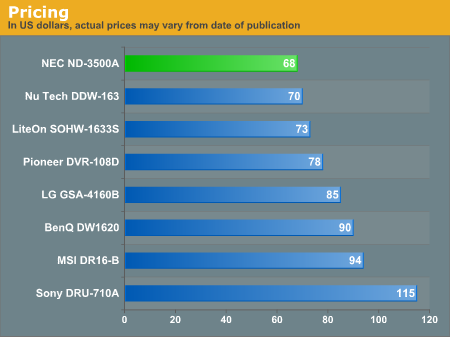
So it looks like NEC has done it again with pricing, placing a $68 tag on the ND-3500A. NuTech follows at $70 with its DDW-163 and the SOHW-1633S at $3 higher. We were disappointed to see the DRU-710A priced so high, $115, for the performance it gave us on this test run. Hopefully Sony will work on firmware updates to help their unit climb the charts.
Final Words
We have taken these 16X dual layer capable burners and thrown various media at them to see how each unit burns and reads back. From our results, we can see that the Pioneer DVR-108D, LG GSA-4160B, and NEC's ND-3500A came out on top with their ability to burn any type of media almost flawlessly as well as burn 2.4X dual layer media at 4.0X speeds (DVR-108D & ND-3500A). Our graphical presentations show that these three drives have the best read and write performance as far as DVD+/-R/RW media goes, and also top the list in dual layer write performance. The ND-3500A does have the highest CD read and right speeds by a hair, with LG's GSA-4160B coming in at second resulting in read/write times of 32.80X/29.15X, respectively.We were extremely disappointed to see that MSI's DR16-B and Sony's DRU-710A produced dual layer coasters, since we had expected these big names to put out exceptional products. We hope with future firmware updates, these manufacturers can resolve the issues so that their products can be more competitive in the 16X market. The 710A wrote to our 80min Fujifilm CDRs the quickest of the bunch at an average of 32.36X, and only came second to the NEC ND-3500A in DVD+R 16X writing tests with LiteOn's SOHW-1633S, but couldn't come close to the top of the list in any other area.
Various features set these 8 burners apart from each other as well as others that are being introduced into the market. One feature that we thought would make a world of difference is the ability to change the "Book Type" of a disc when writing to it. This bitsetting feature is implemented in 5 out of the 8 drives on the list. In particular, the feature in the ND-3500A helps bring the unit to the top of the list. If LG had implemented bitsetting into their GSA-4160B, it would have helped their product climb the ladder to compete with the NEC drive.
 To NEC's ND-3500A for exceptional DVD+DL, DVD+/-R, CDR write speed and quality at a fair price.
To NEC's ND-3500A for exceptional DVD+DL, DVD+/-R, CDR write speed and quality at a fair price.Unlike CDRs, the DVDR world is plagued with the dual standards, which make it slightly difficult to maintain compatibility with standalone DVD players. For this reason, the bitsetting feature might come in handy more than the ability to read and write DVD-RAM media. This is what kept LG's unit from winning the #1 spot, which we have awarded to the NEC ND-3500A. Its read and write performance and quality as well as its inclusion of the bitsetting feature and high DL write speeds along with a price of $68, which is the lowest price of all 8 drives, puts the drive at the top of our list with the gold medal.
Surprisingly absent from this roundup were any representatives of Sanyo or Ricoh 16X drives. The Plextor PX-716A probably utilizes a Sanyo chipset, given their track record, but we could not obtain a sample in time for the roundup. Ricoh's extremely anticipated 16X core seems to have all but vanished, even from the drives that were supposed to ship with it - including the NuTech DDW-162 featured today. A late entrance from both chip makers does not bode well, but we look forward to featuring both in the next DVD recording roundup!

